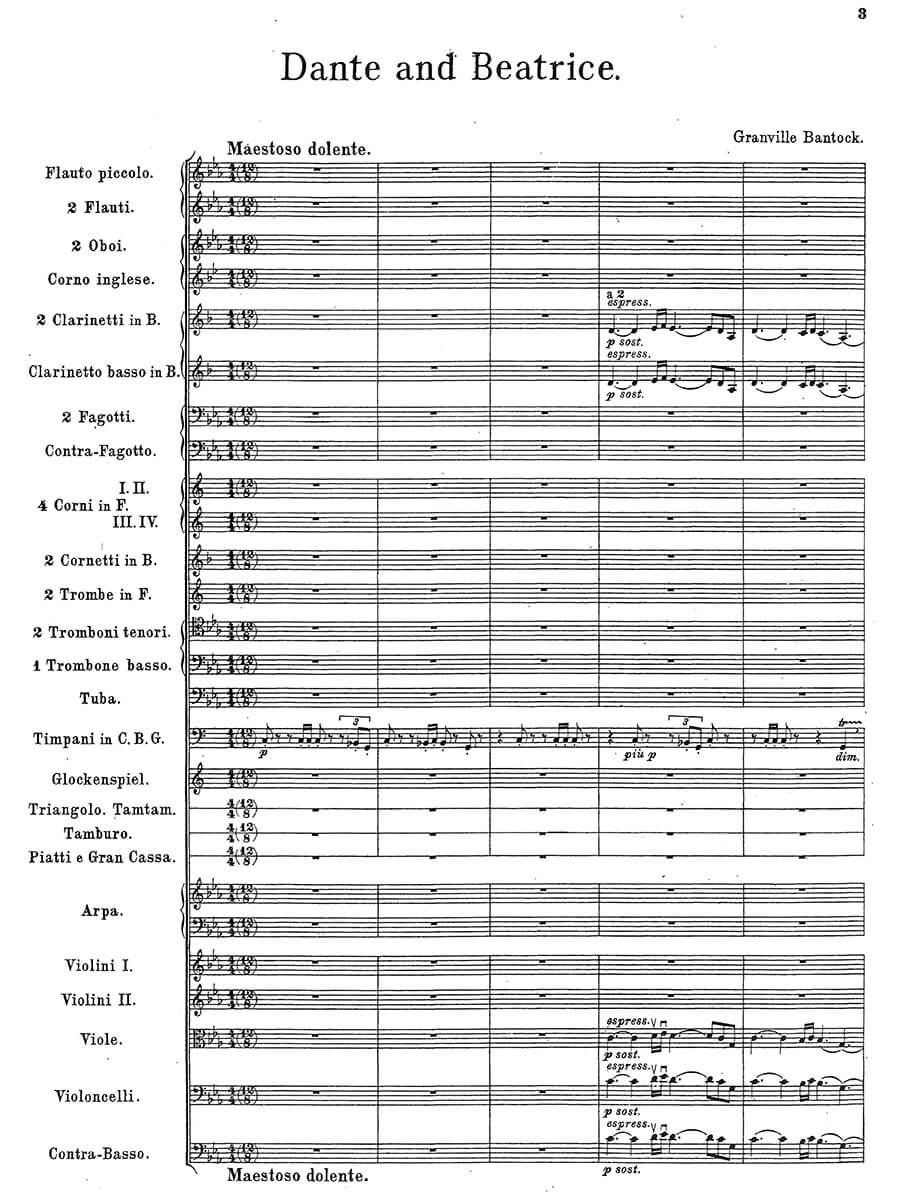Dante and Beatrice, Tone poem
Bantock, Granville
29,00 €
Preface
Granville Bantock
(b. London, 7th August 1868 – d. London, 11th October 1946)
Dante and Beatrice
1910, premiered and published 1911 (Revision of Dante, 1901, premiered 1902)
Preface
Granville Ransome Bantock was born in London on August 7, 1868. He was the son of the surgeon and gynecologist George Granville Bantock. In 1884, at age 16, Bantock began showing a strong interest in music, and he came to regard music as his chosen profession. His father opposed this desire, and Bantock prepared for the Indian Civil Service Examinations at his father’s wish, but was unable to sit for the examinations because of illness. His father next chose chemical engineering as a profession for his son, but engineering study soon gave way to concert-going and study of music scores. The Principal of the City and Guilds Institute realized that Bantock’s heart was not in engineering, and helped persuade Bantock’s father to allow young Granville to study music – first private harmony and counterpoint lessons and then, after an 1889 visit to Germany where he saw Wagner’s Parsifal and Tristan und Isolde, at the Royal Academy of Music (RAM). A student of composition, his most significant instructor at RAM was Frederick Corder (1852-1932), who, with his wife, produced the first accepted translations of Wagner’s Der Ring des Nibelungen. In only Bantock’s second term at RAM, and with little formal music instruction, he won the Macfarren Scholarship.
Graduation from the Royal Academy in 1893 left Bantock at loose ends and with few prospects. He was offered a position grading examination papers for the Trinity College of Music, and began, with almost no capital, a music periodical called The New Quarterly Musical Review. Bantock persuaded some of the finest musicians of the time to contribute to his journal without recompense, but the journal folded in 1896. The only article bearing Bantock’s name was entitled Confucianism and Music, an early sign of Bantock’s love and respect for things oriental.
Bantock obtained his first regular position in music from a theatrical agent, which involved touring the provinces in a burlesque entitled Little Boy Blue. This led to other similar engagements, culminating in an appointment as conductor with George Edwardes’ Gaiety Company. During 1894-1895 Bantock toured the United States and Australia with Edwardes’ company in several pieces, including The Gaiety Girls. After his return to England, he was engaged to take Shamus O’Brien, Charles Villiers Stanford’s (1852-1924) romantic comedy, on tour in England and Ireland.
After his return from America, Bantock met and became engaged to the woman he would marry, Helena Schweitzer. Their marriage took place in March 1898. Miss Schweitzer supplied the words for Bantock’s Songs of the East, and continued to act as librettist throughout his career.
In 1897 Bantock was appointed music director at New Brighton, a pleasure resort. His duties included conducting a military band and a ballroom orchestra. Bantock transformed the ballroom orchestra, for special concerts, into a symphony orchestra performing Beethoven, Tchaikovsky, and other classical masters. Jean Sibelius visited England at Bantock’s invitation, and his first symphony was performed in Liverpool. Sibelius later dedicated his third symphony to Bantock…
Komplettes Vorwort lesen > HERE
Score Data
| Edition | Repertoire Explorer |
|---|---|
| Genre | Orchestra |
| Size | 210 x 297 mm |
| Printing | Reprint |
| Pages | 100 |
